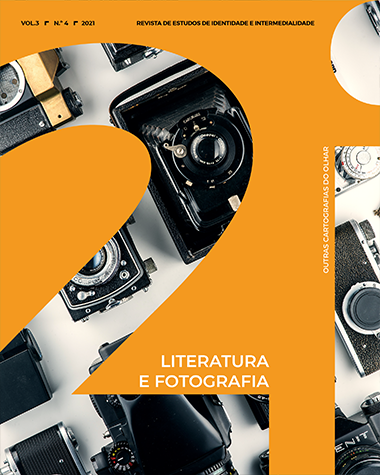Sharing absence
Perspective and community in the photographic series 'Ausencias', by Gustavo Germano
DOI:
https://doi.org/10.21814/2i.3445Keywords:
Perspective, Photography, Montage, CommonAbstract
This essay focus on Ausencias, a series of photographs by the Argentinean born and settled in Catalonia Gustavo Germano. Through a concern with the photographic support and the montage process, the text aims to stablish some relations between the photographic series and the aesthetic perception problematics, based on some notes by David Lapoujade towards the possibility of photographs’ reception to be configured as a participation or a transference of point of view. In the same way, the essay aims to analyse the photographs as ways of un-automatization of seeing and of exiting an “anesthetic” effect of art and perception as noted by Susan Buck-Morss. The essay seeks also to demonstrate the uses of the “face” as a means of identification in the photographic series, understanding it as a kind of pre-linguistic communication that tries to overcome the difference from the other without effacing it completely. Therefore, Germano’s photographic gesture gives the basis to imagine an expansion of the disappearance’s standpoint beyond the enclosures of family or of the politics of memory in the public sphere, staging an art of the Common, leaving the public-private dichotomy and entering a south-american sharing of the past.
Downloads
References
Agamben, G. (2017). O uso dos corpos. (trad. Selvino J. Assmann). São Paulo: Boitempo.
_____ (2007). Profanações. (trad. Selvino J. Assmann). São Paulo: Boitempo.
Arfuch, L. (2018). (Auto)figuraciones de infancia. In La Vida narrada: Memoria subjetividad y politica. Villa María: Eduvim.
Barbosa, J. (2018). Sociedades do desaparecimento. Revista Reflexões, 7(12), 47–58. Consultado em https://revistareflexoes.com.br/wp-content/uploads/2018/01/3.1-Jhonefer.pdf
Barthes, R. (1984). A câmara clara: Notas sobre a fotografia. (trad. Júlio Castañon Guimarães). Rio de Janeiro: Nova Fronteira.
Benjamin, W. (2020). Sobre o conceito de História. (trad. Adalbertu Muller e Márcio Seligmann-Silva). São Paulo: Alameda.
Buck-Morss, S. (1992). Aesthetics and anaesthetics: Walter Benjamin’s artwork essay reconsidered. October (62), 3–41.
Butler, J. (2004). Precarious life. In. Precarious Life. New York: Verso Books.
_____ (2018). Quadros de guerra: Quando a vida é passível de luto? (trad. Sérgio Tadeu de Niemeyer Lamarão e Arnaldo Marques da Cunha). 5ª ed. Rio de Janeiro: Civilização Brasileira.
Calveiro, P. (2013). Poder e desaparecimento: Os campos de concentração na Argentina. Trad. Fernando Correa Prado. São Paulo: Boitempo.
Dardot, P. & Laval, C. (2017). Comum: Ensaio sobre a revolução no século XXI (trad. Mariana Echalar). São Paulo: Boitempo.
Didi-Huberman, G. (2017). Quando as imagens tomam posição. O olho da história I. (trad. Cleonice Paes Barreto Mourão). Belo Horizonte: Editora UFMG.
Felman, S. (1992). Camus’s The Plague, or a monument to witnessing. In Felman, S. & Laub, D. Testimony: Crises of witnessing in literature, psychoanalysis, and history. New York: Routledge.
Forné, A. (2015). El arte de la reversibilidad em cuatro relatos de familiares desaparecidos. Alter/naticas (5), 1–17.
Germano, G. (2018). Portfólio. Consultado em https://www.gustavogermano.com/portfolio/ausencias-uruguay-2016/
Hardt, M. & Negri, A. (2016). Bem-estar Comum. (trad. Clóvis Marques). 1ª ed. Rio de Janeiro: Record.
Hirsch, M. (2008). The generation of postmemory. Poetics Today, 29(1), 103–128. https://doi.org/10.1215/03335372-2007-019
Klinger, D. (2018). Corpo, herança, memória e miragem do eu. Revista fronteira Z. (20), 35–45.
Kucinski, B. (2016). K.: Relato de uma busca. São Paulo: Editora Companhia das Letras.
Laddaga, R. (2006). Espectáculos de realidad: ensayo sobre la narrativa latinoamericana de las últimas décadas. Comunicação & política, 24(3), 154–178.
Lapoujade, D. (2017). As existências mínimas. (trad. Hortencia Santos Lancastre). São Paulo: n-1.
Lims, T. R. (2016). Ausenc’as. Informática na educação: teoria & prática., 21(1), 86–105.
Miles, M. (2016). Rephotography in the era of the witness. Photographies, 9(1), 51–69.
Rappini, R. (2018). Ausencias. Geekness. Consultado em: https://geekness.com.br/ausencias/.
Santos, A. C. L. (2018). Entrevendo olhares espectrais: As fotografias das vítimas da ditadura em obras de arte contemporâneas. ARS, 16(34), 233–259.
Seligmann-Silva, M. (2010). O local do testemunho. Tempo e argumento. 2(1), 3–20.
Semana. (2021, maio 4). Defensoría del Pueblo reporta 89 personas como desaparecidas durante el paro nacional en Colombia. Semana.com. Consultado em https://www.semana.com/nacion/articulo/defensoria-del-pueblo-reporta-89-personas-como-desaparecidas-durante-el-paro-nacional-en-colombia/202138/
Sontag, S. (2005). On photography. New York: Rosetta Books.
Traverso, E. (2012). O passado, modos de usar: História, memória e política. (trad. Tiago Avó). Lisboa: Unipop.
Van Dembroucke, C. (2010). The absence made visible: The case of ausen’as, Gustavo Germanos’s photographic exposition. InTensions, (4), 1–26.
Downloads
Published
How to Cite
Issue
Section
License
Copyright (c) 2021 Gabriel de Miranda

This work is licensed under a Creative Commons Attribution-NonCommercial 4.0 International License.


.jpg)










